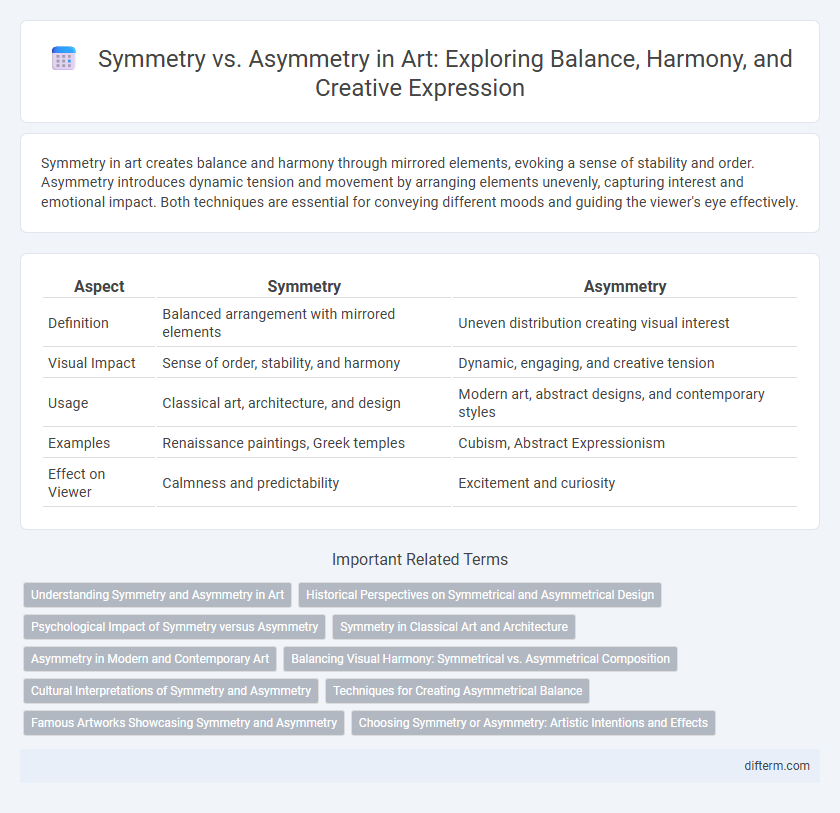Symmetry in art creates balance and harmony through mirrored elements, evoking a sense of stability and order. Asymmetry introduces dynamic tension and movement by arranging elements unevenly, capturing interest and emotional impact. Both techniques are essential for conveying different moods and guiding the viewer's eye effectively.
Table of Comparison
| Aspect | Symmetry | Asymmetry |
|---|---|---|
| Definition | Balanced arrangement with mirrored elements | Uneven distribution creating visual interest |
| Visual Impact | Sense of order, stability, and harmony | Dynamic, engaging, and creative tension |
| Usage | Classical art, architecture, and design | Modern art, abstract designs, and contemporary styles |
| Examples | Renaissance paintings, Greek temples | Cubism, Abstract Expressionism |
| Effect on Viewer | Calmness and predictability | Excitement and curiosity |
Understanding Symmetry and Asymmetry in Art
Symmetry in art creates balance and harmony by mirroring elements on either side of a central axis, fostering visual stability and aesthetic appeal. Asymmetry relies on the strategic arrangement of differing elements to generate dynamic tension, movement, and interest within a composition. Understanding the interplay between symmetry and asymmetry enhances an artist's ability to evoke emotional responses and guide viewers' attention effectively.
Historical Perspectives on Symmetrical and Asymmetrical Design
Historical perspectives on symmetrical and asymmetrical design reveal a deep-rooted tension between order and dynamism in art. Classical art and architecture, such as Greek temples and Renaissance paintings, emphasized symmetry to convey balance, harmony, and divine proportion, reflecting cultural ideals of perfection. In contrast, modern and contemporary movements like Cubism and Abstract Expressionism embraced asymmetry to evoke movement, emotional intensity, and the complexity of human experience.
Psychological Impact of Symmetry versus Asymmetry
Symmetry in art often evokes feelings of balance, harmony, and calmness, engaging viewers with a sense of order and stability that is psychologically comforting. Asymmetry, conversely, introduces dynamism, tension, and unpredictability, stimulating cognitive engagement and emotional response by breaking expectations. The psychological impact varies according to cultural context and individual perception, influencing how artworks communicate mood and meaning.
Symmetry in Classical Art and Architecture
Symmetry in Classical Art and Architecture serves as a fundamental principle, emphasizing balance, harmony, and proportion. Iconic structures like the Parthenon and Renaissance paintings by Leonardo da Vinci exemplify the use of bilateral and radial symmetry to create visual stability and aesthetic perfection. This adherence to symmetrical forms reflects ancient Greek ideals of order and beauty, shaping Western artistic and architectural traditions for centuries.
Asymmetry in Modern and Contemporary Art
Asymmetry in modern and contemporary art challenges traditional balance by embracing irregular forms, dynamic compositions, and unexpected visual tensions that evoke emotional responses and provoke thought. Artists like Jackson Pollock and Willem de Kooning utilize asymmetrical arrangements to create movement and energy, breaking free from classical symmetry's predictability. This approach reflects the complexities of modern life, emphasizing individual expression and innovative aesthetics over conventional harmony.
Balancing Visual Harmony: Symmetrical vs. Asymmetrical Composition
Symmetrical compositions create balance through mirrored elements, fostering visual stability and calmness that guides the viewer's eye evenly across the artwork. Asymmetrical compositions achieve harmony by distributing visual weight non-uniformly, using contrasts in color, shape, and space to evoke dynamic movement and interest. Both approaches strategically manipulate visual elements to establish cohesive and engaging art, enhancing emotional impact and viewer engagement.
Cultural Interpretations of Symmetry and Asymmetry
Symmetry in art often symbolizes balance, harmony, and order, reflecting cultural values found in classical Western and Eastern aesthetics, where symmetrical structures are associated with beauty and perfection. Asymmetry, conversely, is embraced in various cultures such as Japanese wabi-sabi, highlighting imperfection, transience, and natural beauty, which challenges conventional ideals by celebrating irregularity and spontaneity. These cultural interpretations influence artistic expression by shaping perceptions of visual stability and emotional resonance within diverse artistic traditions.
Techniques for Creating Asymmetrical Balance
Techniques for creating asymmetrical balance in art involve strategically distributing visual weight through contrasting elements such as color, texture, and shape. Artists often use scale variation, color intensity, and spatial arrangement to achieve harmony without mirroring. Employing focal points and dynamic lines helps maintain equilibrium while enhancing visual interest and movement.
Famous Artworks Showcasing Symmetry and Asymmetry
Famous artworks like Leonardo da Vinci's "Vitruvian Man" and Albrecht Durer's "Melencolia I" showcase perfect symmetry, emphasizing balance and harmony through proportion and mirrored elements. In contrast, paintings such as Jackson Pollock's "Number 31" and Francis Bacon's "Study after Velazquez's Portrait of Pope Innocent X" highlight asymmetry, evoking dynamic motion and emotional tension by disrupting traditional balance. These masterpieces demonstrate how symmetry and asymmetry serve as powerful compositional tools to influence viewer perception and artistic expression.
Choosing Symmetry or Asymmetry: Artistic Intentions and Effects
Choosing symmetry in art conveys balance, harmony, and stability, often evoking a sense of order and calmness; artists use it to create visually pleasing and structured compositions. Asymmetry, on the other hand, generates dynamic tension, movement, and intrigue, allowing for expressive, unpredictable, and emotionally engaging works. The decision between symmetry and asymmetry reflects the artist's intention to either emphasize consistency and formality or to introduce contrast and vitality within the piece.
Symmetry vs Asymmetry Infographic

 difterm.com
difterm.com